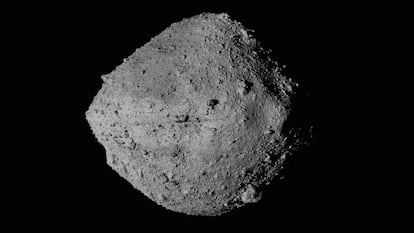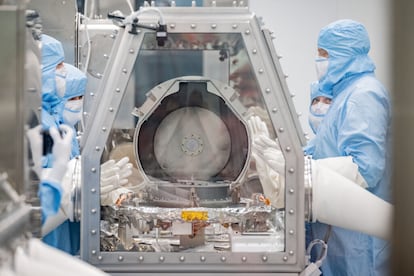NASA finds signs of the ‘building blocks of life’ in sample brought back from Bennu asteroid
The dirt and rocks collected by the space agency’s OSIRIS-REx probe contain water and carbon, reinforcing the idea that these elements could have reached Earth in meteorites

Preliminary studies of samples from the 4.5-billion-year-old asteroid Bennu show evidence of water and a high carbon content, which NASA says “could indicate the building blocks of life on Earth may be found in the rock.” On September 24, a capsule that had made a 6.2 billion-kilometer galactic journey to the asteroid Bennu and back to Earth landed with great precision in the Utah desert. The capsule, dropped by the OSIRIS-REx probe, carried inside it more than two ounces (60 grams) of black dirt and rocks from the surface of this 500-meter-long (1,610 ft) space rock, which is the most threatening to Earth in terms of a potential collision and which holds secrets about the origin of our galactic neighborhood, NASA explained.
During the first past two weeks, scientists have conducted a “quick-look” analysis for an initial understanding of the material from Bennu, the third asteroid from which samples have been collected to be brought back to Earth. In a presentation at the Johnson Space Center in Houston, NASA Administrator Bill Nelson said that “the OSIRIS-REx sample is the biggest carbon-rich asteroid sample ever delivered to Earth and will help scientists investigate the origins of life on our own planet for generations to come.” Initial analysis shows the presence of water and carbon molecules, which are necessary for life, Nelson explained.
“As we peer into the ancient secrets preserved within the dust and rocks of asteroid Bennu, we are unlocking a time capsule that offers us profound insights into the origins of our solar system,” added Dante Lauretta, OSIRIS-REx principal investigator, from the University of Arizona, Tucson.
“The bounty of carbon-rich material and the abundant presence of water-bearing clay minerals are just the tip of the cosmic iceberg,” said Lauretta. “These discoveries, made possible through years of dedicated collaboration and cutting-edge science, propel us on a journey to understand not only our celestial neighborhood but also the potential for life’s beginnings. With each revelation from Bennu, we draw closer to unraveling the mysteries of our cosmic heritage.”

As soon as it landed, technicians transported the artifact to the Johnson Space Center in Houston to treat it with extreme care to avoid contamination. Once at the laboratory, the specialists managed to open the canister lid, but came up against problems: scientists discovered bonus asteroid material covering the outside of the collector head, canister lid, and base. “There was so much extra material it slowed down the careful process of collecting and containing the primary sample,” the agency reported.
Until now, five grams of 4.5 billion-year-old soil extracted from the asteroid Ryugu were considered the oldest material in the solar system to be brought back, thanks to the Japanese mission carried out by the Hayabusa 2 space probe. This capsule returned to Earth in 2020 and its analysis showed that it carried uracil, one of the four letters of RNA, the essential molecule for life. This proved that this compound is present in space and reinforced the hypothesis that organic molecules present in asteroids and comets contributed to the prebiotic evolution of the Earth. It took Japan three years to publish the results of this research.

Asteroids are, in a sense, time capsules. They are considered fossils of the solar system, holding the keys to understanding the formation of our planetary neighborhood, and they are being studied to analyze whether they were at the origin of water and even the life that arose on Earth. It is suspected that these space travelers could have transported both water from the oceans and the building blocks of the first organic compounds.
The first part of the round-trip mission was completed by reaching the asteroid Bennu, which circles the Sun between Mars and Earth, when it was at a point more than 300 million kilometers away from Earth. There, it collected a handful of dirt and rocks, a portion of which will remain unstudied for future scientists. Bennu is expected to cross paths with the Earth on September 24, 2182, and there would be a one in 2,700 risk of impact, according to NASA.
This NASA project is the third to successfully bring asteroid fragments back to Earth, following the success of the Japanese probes Hayabusa 1 and 2 in 2010 and 2020, respectively. In 2005, Hayabusa 1 obtained a few particles from the asteroid Itokawa, and returned in 2010 after an eventful five-year journey back. The upgraded version of that probe, Hayabusa 2, collected five grams from Ryugu. Now, OSIRIS-REx is back with more than 10 times that amount. In the meantime, the OSIRIS-REx probe is already preparing for its next mission to meet the asteroid Apophis, which will pass close to Earth in 2029, just 30,000 kilometers away.
Sign up for our weekly newsletter to get more English-language news coverage from EL PAÍS USA Edition
Tu suscripción se está usando en otro dispositivo
¿Quieres añadir otro usuario a tu suscripción?
Si continúas leyendo en este dispositivo, no se podrá leer en el otro.
FlechaTu suscripción se está usando en otro dispositivo y solo puedes acceder a EL PAÍS desde un dispositivo a la vez.
Si quieres compartir tu cuenta, cambia tu suscripción a la modalidad Premium, así podrás añadir otro usuario. Cada uno accederá con su propia cuenta de email, lo que os permitirá personalizar vuestra experiencia en EL PAÍS.
¿Tienes una suscripción de empresa? Accede aquí para contratar más cuentas.
En el caso de no saber quién está usando tu cuenta, te recomendamos cambiar tu contraseña aquí.
Si decides continuar compartiendo tu cuenta, este mensaje se mostrará en tu dispositivo y en el de la otra persona que está usando tu cuenta de forma indefinida, afectando a tu experiencia de lectura. Puedes consultar aquí los términos y condiciones de la suscripción digital.
More information
Últimas noticias
EU’s prestige at stake with proposal to fund Ukrainian war effort with Russian assets
Mustafa Suleyman: ‘Controlling AI is the challenge of our time’
Venezuela breaks energy agreements with Trinidad and Tobago due to alleged complicity with the US
The murder of Michele and Rob Reiner: A tale of horrific days in Hollywood
Most viewed
- ‘El Limones’ and the growing union disguise of Mexican organized crime
- Christian Louboutin: ‘Young people don’t want to be like their parents. And if their parents wear sneakers, they’re going to look for something else’
- ‘We are dying’: Cuba sinks into a health crisis amid medicine shortages and misdiagnosis
- A mountaineer, accused of manslaughter for the death of his partner during a climb: He silenced his phone and refused a helicopter rescue
- The low-cost creative revolution: How technology is making art accessible to everyone











































